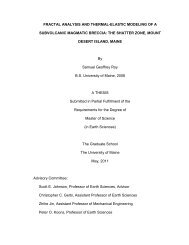Responses of Benthos to Changing Food Quality and Quantity, with ...
Responses of Benthos to Changing Food Quality and Quantity, with ...
Responses of Benthos to Changing Food Quality and Quantity, with ...
Create successful ePaper yourself
Turn your PDF publications into a flip-book with our unique Google optimized e-Paper software.
<strong>Responses</strong> <strong>of</strong> <strong>Benthos</strong> <strong>to</strong> <strong>Changing</strong> <strong>Food</strong> <strong>Quality</strong> <strong>and</strong> <strong>Quantity</strong> 249<br />
SEDIMENTARY CONSEQUENCES OF BIOLOGICAL<br />
STRUCTURE AND FUNCTION<br />
Stratigraphic Resolution<br />
If one accepts the argument that deposit feeding is the principal component<br />
<strong>of</strong> bioturbation, then can one rationalize the biological patterns noted above<br />
<strong>with</strong> observed stratigraphic resolution Moreover, can one suggest particularly<br />
good places (outside anoxic basins) <strong>to</strong> look for improved resolution<br />
Unfortunately, the most obvious answer-<strong>to</strong> look where suspension feeders<br />
that do not rummage through the sediments for food dominate-is not a<br />
good one . Metazoan suspension feeders simply are <strong>to</strong>o rare in the deep sea<br />
ever <strong>to</strong> dominate s<strong>of</strong>t bot<strong>to</strong>ms . The best one can hope for is <strong>to</strong> find variations<br />
in the abundances, sizes, <strong>and</strong> activity levels <strong>of</strong> deposit feeders .<br />
Guinasso <strong>and</strong> Schink (1975) provide a nondimensional index (G) <strong>of</strong> mixing<br />
intensity that varies inversely <strong>with</strong> stratigraphic resolution :<br />
D,<br />
G L b S<br />
(1)<br />
where S is sediment accumulation rate (thickness per unit <strong>of</strong> time) <strong>and</strong> L,,<br />
is the thickness <strong>of</strong> the layer in which bioturbation occurs . Variations in L b<br />
<strong>and</strong> Db are quite limited so that the best stratigraphic resolution <strong>to</strong> date<br />
has been observed in areas <strong>with</strong> highest values <strong>of</strong> S (Schindel 1980 ;<br />
Shiffelbein 1984) . A modest increase in Lb <strong>with</strong> increasing flux <strong>of</strong> organic<br />
carbon <strong>and</strong> sedimentation rate (Berger, personal communication) is consistent<br />
<strong>with</strong> the idea that deeper burrowing costs can be repaid when fluxes <strong>and</strong><br />
concentrations <strong>of</strong> organic carbon are higher at greater sediment depths . It<br />
is tempting <strong>to</strong> speculate that the relative invariance <strong>of</strong> L b is due <strong>to</strong> rapidly<br />
increasing costs <strong>of</strong> deeper burrowing as the sedimentary overburden<br />
increases . L b does not scale <strong>with</strong> the most deeply burrowing species found<br />
at a site ; depth <strong>of</strong> deepest burrowing is nearly invariably larger . Note also<br />
that this mixing relation is developed only for regions free <strong>of</strong> obvious<br />
complications from turbidites . The range in G, nonetheless, is smaller than<br />
one would expect if D b were independent <strong>of</strong> S . Over the full range <strong>of</strong><br />
gradual sediment accumulation rates seen in the deep sea, one expects<br />
animal size <strong>and</strong> abundance <strong>to</strong> vary directly <strong>with</strong> S, but <strong>with</strong> a great deal <strong>of</strong><br />
scatter due <strong>to</strong> variations in horizontal fluxes . The greatest apparent deepsea<br />
values for D b in regions <strong>of</strong> continuous sedimentation have indeed been<br />
measured in nearshore regions <strong>of</strong> high productivity . However, since individual<br />
feeding rate (evolutionary time scale) by Cammen's (1980) arguments varies<br />
inversely <strong>and</strong> animal abundance varies directly <strong>with</strong> sedimentary organic
















